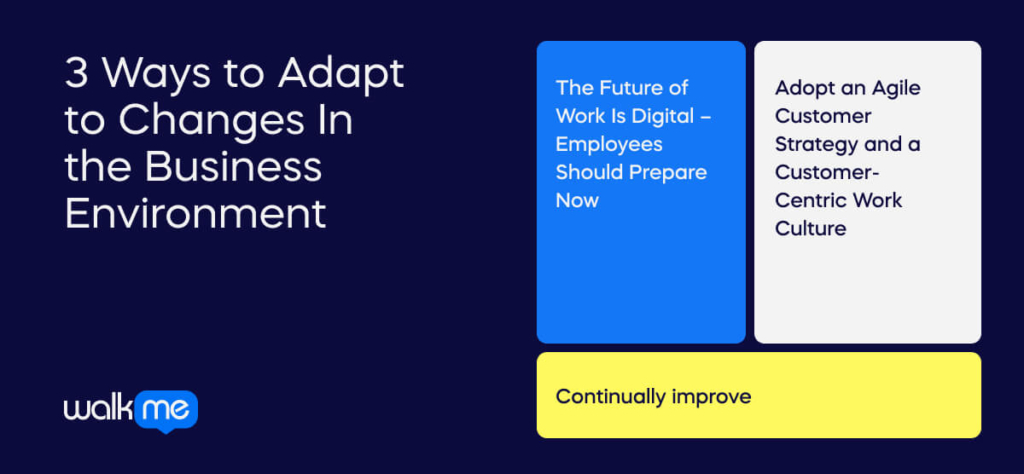How can organizations adapt to changes in the business environment?
As most of us know, today’s business environment is fast-paced and volatile.
Digital disruption, financial fluctuations, customer attitudes, COVID-19, and other forces are driving continual change in today’s business landscape.
To keep up, stay relevant, and stay profitable, businesses and their employees must learn to adapt.
Below, we’ll take a look at some of the ways employees and employers can adapt to and maintain business continuity in today’s uncertain economic conditions.
3 Ways to Adapt to Changes In the Business Environment

To adapt to changes in the business landscape, it is useful to understand what those changes are and why they are occurring.
The factors mentioned above are a few of the biggest forces driving change in today’s economy.
For example:
- Digital disruption has driven changes such as the adoption of the internet, mobile technology, remote working, and much more
- Financial crises also cause changes to the business landscape and can affect everything from customer spending habits to international trade to the health of industries
- COVID-19 has influenced customer spending habits, the workplace, the economy, and more
All of these changes are just a few examples of the multitude of forces that constantly affect the business environment. The ones listed here are among the most prominent, so it is useful to understand how they are influencing the business world.
Here are a few ways that organizations can adapt to the changes we are seeing in today’s business world:
The Future of Work Is Digital – Employees Should Prepare Now
Not only is the future of work digital, the present work environment is also digital.
Digital disruption, as mentioned, is one of the largest forces affecting the modern business world and it will continue to change the business world for years, if not decades.
Here are a few changes to look for in the years ahead:
- Automation will reshape job categories. Automation platforms can enhance employee productivity by performing repetitive and tedious tasks. On the one hand, this will reduce the need for certain types of jobs, such as low-skilled administrative positions. On the other, it will increase the demand for technically skilled jobs, such as those requiring mathematics and computer science.
- The workplace will become even more digital. Today’s workplace is digital-first. Employees spend the vast majority of their day using digital technology, and every day that passes sees the introduction of new tools and digital workflows. in the years ahead, software will likely continue to proliferate and fundamentally reshape the modern workplace.
- Emerging technologies will fundamentally transform the workplace. Technologies such as OCR, augmented reality, virtual reality, 3D printing, and the Internet of Things will all reshape the workplace. In the years ahead, for instance, all of these technologies will become as integral to the workplace as the internet has.
In short, all of these trends point towards a future of work that is digitized and different from the workplace many of us have known.
To adapt to these changes in tomorrow’s business environment, it is important to adopt both the right skills and the right mindset.
Employee training programs can give workers the skills they need to stay successful and productive in a digital-first workplace. Likewise, cultivating a digital culture can help employees embrace learning and stay adaptable.
Adopt an Agile Customer Strategy and a Customer-Centric Work Culture
Agile ways of thinking are built around customers, collaboration, and data. The focus is on adapting to changing conditions, making agile highly suitable for disruptive business environments.
Not only is it a useful business principle, it is an excellent approach to take when designing customer strategies.
A customer strategy that is agile:
- Continually incorporates customer feedback and input into products and services
- Focuses on working products and services, rather than documentation and static plans
- Is willing to reshape business processes, units, and methods as needed
Agile is especially valuable in today’s business environment, since customer sentiments changed so rapidly.
There are several reasons for this, including digital disruption, as mentioned above. Other reasons include COVID-19, financial crises, geopolitical tensions, and the passage of time itself.
All of these trends can and do affect customer sentiment.
To keep up, therefore, it is necessary for businesses to continually learn from their customers, collect data, and implement adaptable business practices that can react to changing customer needs in real-time.
Continually improve
Continuous improvement, or kaizen, as it is called in Japanese, is a core principle of many process improvement methodologies. It is a central concept in lean, for instance, which is built around reducing waste and improving quality across the business.
In business, this idea suggests that processes should be constantly optimized and enhanced over time. Continuous improvement can be applied in any area of the business, from employees’ daily workflows to business processes to the organizational strategy itself. By incorporating this concept into the business, employees and the organization’s leaders can ensure that the organization evolves on an ongoing basis. In the years ahead, this type of principle will become essential for those who want to keep evolving in the post-COVID next normal.

